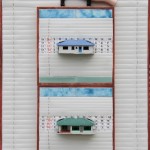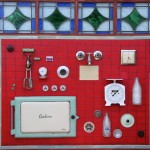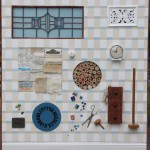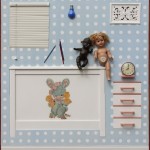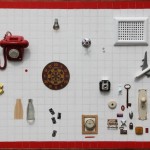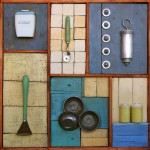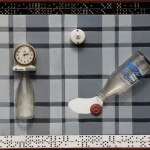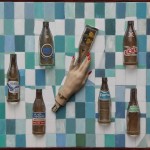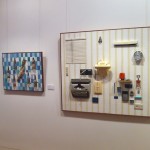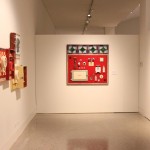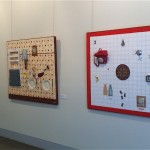MOVING HOUSE
2014 – Cowra Regional Art Gallery, Gosford Regional Art Gallery, Blue Mountains Cultural Centre
2015 – Muswellbrook Regional Arts Centre, Coffs Harbour Regional Gallery, Rockhampton Art Gallery, NERAM Armidale
2017 – Maitland Regional Art Gallery
The iconography of the familiar
“…places borrowed, not places possessed.”
Julie Beck 2011
The house as shelter is fundamental to every culture; its boundaries, the dividing line with the external world. Personified as female – the enclosing maternal aspect – the house is also a metaphor for self; an association teased out by Susan and Peter O’Doherty, in the series of works entitled ‘Moving House.’
The O’Dohertys have lived and worked side by side for more than 20 years. Raised in the 1960s and 70s, they share influences from pop art and culture, and a fascination with the depersonalized icons of Australian suburbia. Both relate their persistent enquiry of these icons to the impermanence of their respective upbringings, with families who moved from one temporary residence to another. Both cite their mothers as key figures in the process.
Exterior/interior – the revealed and the hidden. These are inverse visions; the one portraying soft-focus opaque facades; the other, hard-edged interior details. But despite these polarities, there is much in common. External and internal windows are equally impenetrable. Exteriors and interiors are static, held in place by repeated patterns and motifs. Both visions are devoid of human presence even while it is suggested by empty chairs, a ruffled curtain, a half-open blind.
In one sense, Peter O’Doherty’s houses are an hommage to his father’s craft and his capacity to build the same kind of structure, again and again. Yet, there remains a sense of exclusion, a passive inability to enter, enhanced by the close toned use of colour. The structures are seen in sunlight that peoples the facades with cast shadows suggesting different times of day. It plays across the delicate fretwork of a cast iron rail, the rectangles of door, wall and roof. It infuses the works with a sense of veneration, yet still they remain inaccessible; a window into times lost.
The pop-up culture of the 1950s is represented in various fibro bungalows. Other structures feature an elevated timber Queenslander or a solid red brick house. One sports a striped canvas blind; another, a decorative motif or recessed arch. Yet another evokes the P&O Ocean Liner style, with the words ‘One-O-One’ emblazoned across the entrance. Several houses present ‘the outside room’, the patio or recessed verandah – familiar images to all who were spawned in suburbia. The houses move with the times even while they remain exactly the same.
Susan O’Doherty’s interiors reflect a similar preoccupation with different eras of vernacular architecture; the pre-made environments that offer few concessions to families passing through. In her interiors, objects become the focus of attention in rooms that reflect different aspects of the self. There are windows but no vistas and for the occupants, little opportunity for escape.
A cold forensic light unveils the domestic hierarchy, regimented by patterns of tiles or wallpaper and the horizontals of closed venetian blinds. Here, the modern world has also intruded in the shape of typewriters, telephones and an electric radio. Milk is spilt and scissors lie idle, while leadlight glass and filigree air vents suggest the secluded atmosphere of purdah. In the children’s room, mutilated dolls, with electric sockets in their bellies suggest a fearful existence. Images of time passing are represented by the ever present shape of clocks and other measuring implements – a set of scales, a tape measure, the digital hieroglyphs of dominos.
Two of the images are invaded by a ‘human’ found object – a disembodied female hand, with blazing red fingernails. In one work, it holds the ready-made house/s on a metaphorical string, ready to pack up shop and move on to the next dwelling. In the other, in a semi-obscene gesture, it has one finger stuck up a soft drink bottle, with a domino shoved into its vacant wrist.
Pop culture celebrated standardization as a world where everyone could have the same things, and live in the same houses, and eat the same food, and drink the same drinks. The Australian interpretation added the quarter acre block, plus suburban bungalow, as the acme of material success. In this current work, Susan and Peter O’Doherty offer an eloquent refutation of the Australian dream. There is reverence for the remembered details of childhood but also a sense of time trapped inside unyielding structures. In this context, their reconfiguration of their nomadic childhoods is an act of possession.
Elizabeth Butel
Author and Editor

